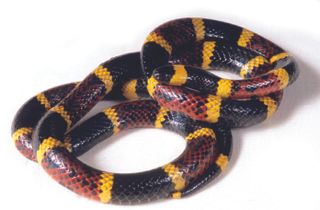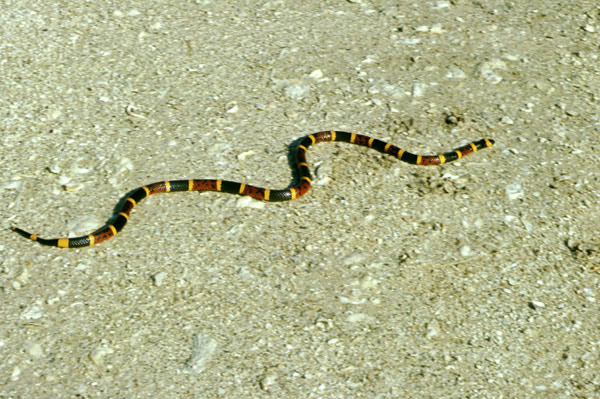Art of a Man Surrounded by Snakes Indiana Jones Snake Pit
Coral Snakes: Colors, Bites, Farts & Facts

Coral snakes are pocket-size, vibrantly colored, highly venomous snakes. They take the second-strongest venom of any serpent (the blackness mamba has the most deadly venom), just they are generally considered less dangerous than rattlesnakes because coral snakes accept a less effective poison-commitment system.
Coral snakes are separated into two groups: the One-time World coral snakes [found in Asia] and the New Earth coral snakes [found in the Americas], according to Sara Viernum, a herpetologist based in Madison, Wisconsin. "New World coral snakes are considered some of the virtually toxic snakes in North America considering their venom contains powerful neurotoxins," she said.
Characteristics
Coral snakes are slender and pocket-sized, typically between 18 and 20 inches long (45 to fifty centimeters), with some species reaching 3 feet (1 meter). According to DesertUSA, the Western coral snake can be as skinny equally a pencil. They have bulbous, almost-neckless heads, rounded noses and similar-looking tails, meaning that it can be hard to tell a snake's caput from its tail.
They apply this characteristic to fool attackers by burying their heads in their coiled bodies and raising their tails — which look quite like to their heads. "The idea for this behavior is that it'due south always better to lose your tail than your head," Viernum said.
When provoked, coral snakes will sometimes brand a popping sound by expelling air from their cloaca, a unmarried opening for the urinary, reproductive and intestinal tract, to startle the threat. According to researcher Joseph F. Gemano Jr. in an article in Reptiles mag, these "microfarts" take been observed in other species, such as the Western hook-nosed snake. Scientists disagree well-nigh the behavior's purpose. Some accept speculated that it is a mating call, but Gemano said that in his research, the fart was always associated with an aggressive-defensive behavior.
Vivid colors
The nearly distinctive physical characteristics of coral snakes are their brightly colored and patterned bodies, short, fixed fangs and potent venom, according to Viernum. While only some species have elements of coral coloring, all species have middle-communicable patterns and colors: red bands flanked by yellow bands.
Because of the coral ophidian's unsafe reputation, many nonpoisonous snakes disguise themselves as coral snakes by having similar body patterns. For example, Viernum said, the nonvenomous shovel-nosed snakehas yellow bands that touch blackness bands. Besides, "Reddish kingsnakes look very similar to Eastern coral snakes, but the red bands of a scarlet kingsnake are next to the blackness bands whereas the red bands of an eastern coral serpent are side by side to the yellow bands."
Viernum said a rhyme was penned "as a way for people to quickly and easily differentiate betwixt a nonvenomous ophidian and the toxic coral snake." One version of the rhyme goes:
Red and yellow, can kill a fellow; Red and black, friend of Jack.
Viernum said that the rhyme is "fairly accurate for snakes in the U.S. but it fails with the Old World coral snakes and many New World species plant in Fundamental and S America." In other parts of the world, coral snakes may have ruby-red bands touching black bands, take pink and blue banding, or have no banding at all.
The best style to identify a coral snake is by its caput, which is edgeless and black to behind the optics, and its bands that completely circle the body instead of breaking at the belly.
Taxonomy/nomenclature
Coral snakes are in the Elapidae family, as are cobras, ocean snakes and black mambas. At that place are nearly seventy species of New World coral snakes and about 15 species of Old Earth coral snakes.
The taxonomy of coral snakes, according to the Integrated Taxonomic Information Organization (ITIS), is:
- Kingdom: Animalia
- Subkingdom: Bilateria
- Infrakingdom: Deuterostomia
- Phylum: Chordata
- Subphylum: Vertebrata
- Infraphylum: Gnathostomata
- Superclass: Tetrapoda
- Class: Reptilia
- Society: Squamata
- Suborder: Serpentes
- Infraorder: Alethinophidia
- Family unit: Elapidae
- Genera (Old Earth): Calliophis, Hemibungarus and Sinomicrusus
- Genera (New Globe): Leptomicrurus, Micruroides and Micrusus
Species: The following are descriptions of the nearly typical or impressive coral snakes:
Eastern coral snake ( Micrurus fulvius ) : Ranging from North Carolina to Florida and Texas, this is the brightest of North American coral snakes. Co-ordinate to the Florida Museum of Natural History, its body is entirely covered in bright bands of blackness, red and yellow. Narrow bright yellow rings separate wider crimson and black rings. There is a yellow ring behind the snake's blackness snout. The tail is ringed in blackness and yellow, with no ruddy.
Western or Arizona Coral snake (Micruroides euryxanthus): This Southwestern North American serpent has the same basic color blueprint as its Eastern counterpart, though the colors are slightly muted. The yellowish bands, particularly, are paler, and can be actually be white, according to the Arizona-Sonora Desert Museum. They are as well wider than the Eastern coral snake's yellow bands.
Bluish Malayan coral snake ( Calliophis bivirgatus ): This stunning snake lives in the jungles of Southeast Asia. Unlike its North American cousins, it does non accept bands. Instead, it has a deep blue body with light bluish or white stripes on each side, and a gorgeous, coral-red head and tail, according to Ecology Asia.

Habitat
Coral snakes that alive in forested or jungle areas spend almost of their fourth dimension burrowed underground or in leaf piles, according to the University of Michigan Museum of Zoology's Animal Diversity Spider web(ADW). They like marshy and wooded areas, but also alive in the scrubby sandhills of the Southeast United States.
Western coral snakes live primarily in the Sonoran Desert of Arizona and Northern Mexico. According to Arizona Leisure, they like to alive under rocks or burrow into sand or soil, and are often found in the rocky areas around Saguaro cacti.
Coral snakes are nocturnal and reclusive. Because of their secretive habits, they may be found in suburban areas. They spend most of their time keeping cozy in burrows or under rocks or rotting leaves. According to the Savannah River Ecology Laboratory, they are most commonly seen in the spring and fall. These snakes are shy and will often abscond from predators.
Diet
Coral snakes consume lizards and other small, smoothed-scaled snakes. National Geographic reported that Eastern coral snakes will eat frogs, and Western coral snakes are particularly fond of devouring blind or blackness-headed snakes, according to the Arizona-Sonora Desert Museum.
Reproduction
Unlike many other venomous snakes that give nascency to alive young, coral snakes lay eggs. According to the ADW, they are the only venomous snakes in Due north America to do and then. Eastern coral snakes lay vi or seven eggs in the summer that hatch in early autumn. Western coral snakes lay 2 to three eggs. Babies are born brightly colored, fully venomous, and seven inches (17 cm) long.
Bite
According to the New Mexico Department of Game and Fish, unlike most other venomous snakes, the coral snake cannot contract its fangs into its mouth. Instead, they are constantly out and erect. Their fangs are relatively weak.
According to National Geographic, though their venom is highly toxic, no deaths from coral snake bites have been reported in North America since the late 1960s, when antivenin was adult. No deaths from a Western coral snake have been reported at all. Nevertheless, their bites can be extremely painful and, if left untreated, tin can lead to cardiac arrest.
Coral snakes' minor, fixed fangs and small mouth mean that it is difficult for them to puncture man skin — let alone leather boots. Humans are mostly bitten when trying to selection upwards a coral ophidian. Considering of their minor size, these snakes don't carry much venom in their fangs, and so they may endeavor to concord onto their victim for some fourth dimension.
According to Viernum, "One of the nigh distinctive behavioral characteristics of coral snakes is how they evangelize their venom. Since their fangs are short and stock-still, they deliver their venom through chewing motions." She described this procedure as "similar to the way Gila monsters deliver their venom to prey."
The snake's neurotoxic venom causes rapid paralysis and respiratory failure in its prey; however, according to the National Institutes of Wellness, it tin can take many hours for symptoms to appear in humans. Additionally, there is often little or no hurting or swelling in humans from a coral serpent seize with teeth. If untreated by antivenom, nonetheless, symptoms volition take effect. They include slurred speech, double vision, and muscular paralysis.
Boosted resources
- Sara Viernum and her squad at "The Wandering Herpetologist," are dedicated to providing news, facts, and educational information about amphibians and reptiles.
- Savannah River Ecology Laboratory: What Practice We Know About Coral Snakes?
- Reptiles magazine: Coral Snake Inquiry
Source: https://www.livescience.com/43938-coral-snakes-colors-bites-farts-facts.html
0 Response to "Art of a Man Surrounded by Snakes Indiana Jones Snake Pit"
Post a Comment